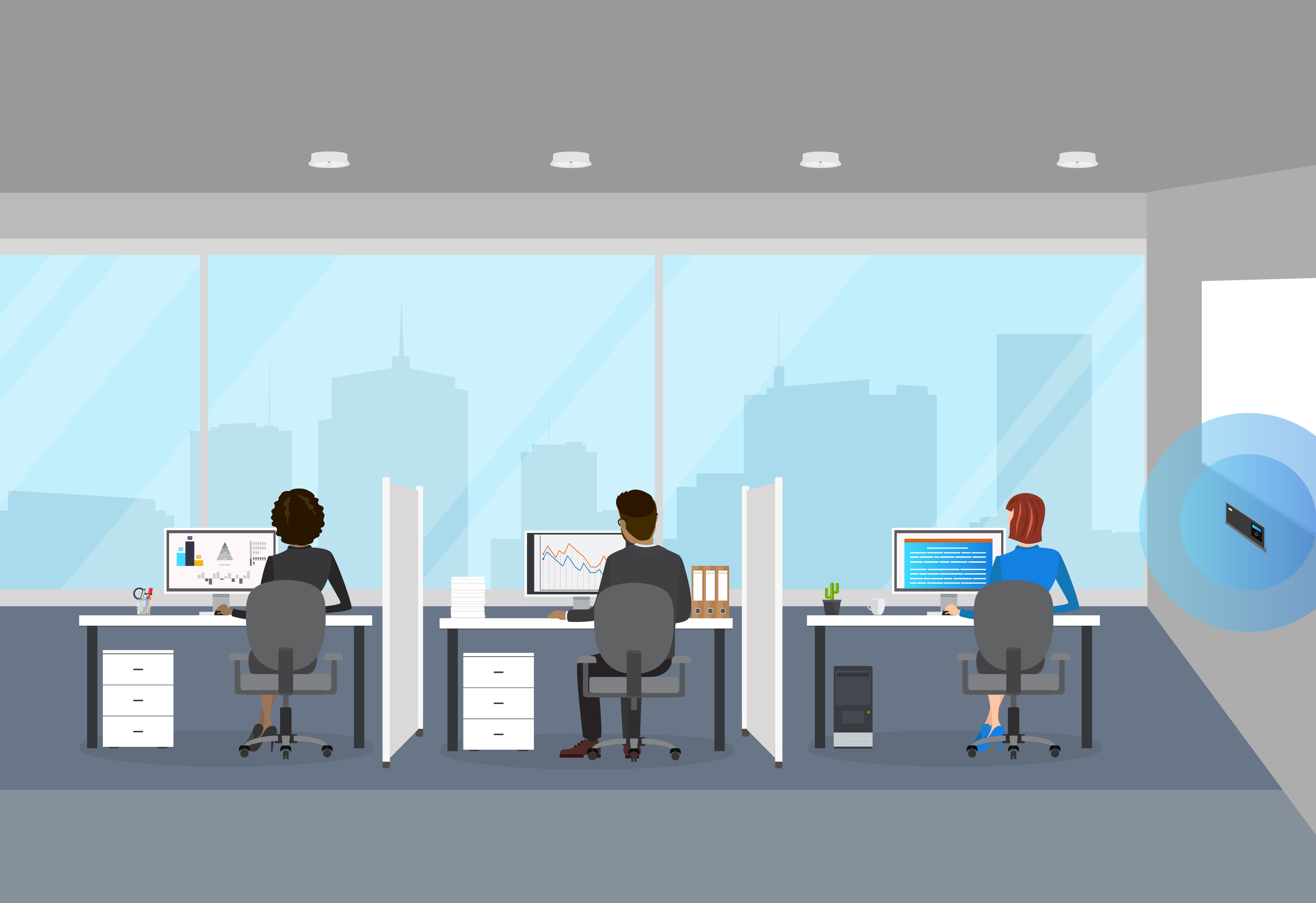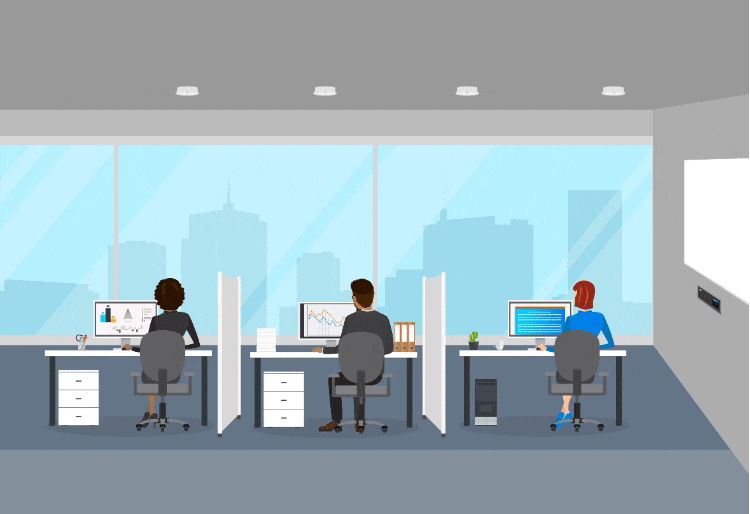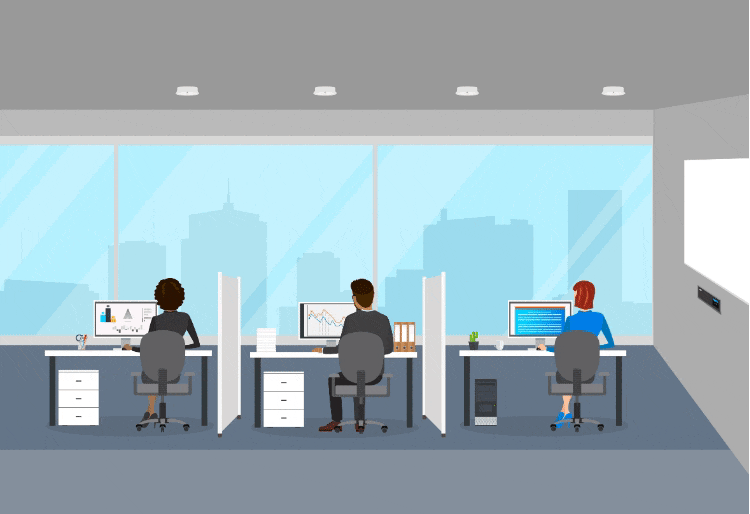Professional Sound Masking Solutions for Offices, Healthcare, and More
Transform your office or workplace acoustics with Biamp Cambridge Qt sound masking solutions from Callisto. With over 150 years of combined expertise, we design and implement precise audio environments that protect sensitive conversations and enhance productivity across healthcare, legal, corporate, government spaces, and more. Headquartered in Chesterfield, we are proud to serve Eastern Missouri and Western Illinois from Cape Girardeau to Belleville and throughout the greater area.
Sound masking is the addition of an unobtrusive background sound that reduces the intelligibility of speech and distractions that can be caused by loud talking and noises in open areas and sensitive spaces. The sound that is produced is barely noticeable and similar to airflow, but it’s specifically tuned to frequencies and amplitudes targeting the human ear so that you have increased privacy, comfort, and overall productivity.
How Our Sound Masking Systems Work

Case StudyProven Results
Discover how Callisto transformed a local financial firm's open office into a private, distraction-free workspace with sound masking solutions from Biamp.
Why Businesses Needs Sound Masking
Closing the door to an office no longer guarantees speech privacy and in doing so, it only provides the illusion of privacy. When designing an optimal acoustic environment, a variety of elements should be considered to address noise control and speech privacy, this is where sound masking comes in. Using the ABCs of acoustic design (Absorb, Block, Cover), sound masking is the “cover” portion of the equation for privacy and noise control. Biamp's QT Quiet Technology can help organizations reach HIPAA requirements and receive LEED points, resulting in increased federal funding and tax breaks. QT systems incorporate overhead music, paging, and sound masking all into one multi-functional device.
Sound Masking vs. White Noise
Sound masking is often confused with white noise and is considered by many to be the next generation of white noise. In office spaces white noise is simply a loud, uniform noise, sounding like loud AM radio static. By contrast, sound masking matches the frequencies of human speech and other common distractions and is specifically engineered to mask conversations for greater speech privacy and productivity. While white noise includes all frequencies at equal energy, the results can be obtrusive. Sound masking creates a more immersive experience that people barely notice.

Sound Masking Solutions For Any Industry
Healthcare
The Health Insurance Portability and Accountability Act (HIPAA) requires all employers (not just hospitals) to create safeguards to protect the privacy of protected health information. Not only does sound masking comply with these standards, but it also improves Hospital Consumer Assessment of Healthcare Providers and Systems (HCAHPS) scores by improving the patient experience with fewer noise distractions. Sound masking is commonly used in Hospitals, Urgent Care Centers, Doctor Offices, and counseling and Therapy Facilities.
Legal Services
Sound masking is used to protect conversations and client confidentiality in the legal space, while also reducing distracting background noise. Common instances where sound masking is used in legal environments include Law Enforcement Agencies, Courtrooms, Conference Rooms, Victim Advocate Centers, and Legal Offices.
Corporate Offices
Corporate spaces have evolved over the years with more open-concept layouts. Sound masking helps reduce noise distractions and protects employee speech privacy in Open Offices, Private Offices, Conference Rooms, HR Offices, and Call Centers. Sound masking can also be installed in new corporate construction for Leadership in Energy and Environmental Design (LEED) certification compliance.
Education
The Family Educational Rights and Privacy Act (FERPA) mandates that educational institutions take the necessary steps to protect student information. Sound masking is used in education to help meet FERPA requirements, keep conversations confidential, and minimize disruptions in Libraries, Student Centers, Classrooms, Administrative Offices, Counseling Offices, Research Labs, and study spaces.
Government
Sound masking is used in government agencies to protect sensitive conversations in SCIFS, Private Offices, Conference Rooms, Open Offices, and other meeting spaces. Sound masking is also used to comply with Leadership in Energy and Environmental Design (LEED)certification which is now more important than ever as US federal agencies, state, and local governments are requiring buildings to attain LEED certification.
Financial Services
The Gramm-Leach-Bliley Act (GLBA) is the HIPAA equivalent for the finance industry. GLBA requires financial institutions to protect their client's non-public financial information. Sound masking helps by safeguarding clients against pretexting and identity theft. It also reduces the risk of negligent disclosure of client information. Sound masking is common in Accounting Offices, Call Centers, Retail Accounting Branches, and Conference Rooms.

Competitive AdvantagesWhy Callisto?
Same-day and international shipping
In House engineers & field technicians
Dozens of new and vintage product lines
150 Years combined experience
Top-notch customer service
Reliable in-house repair center
























